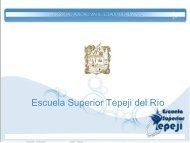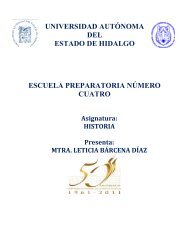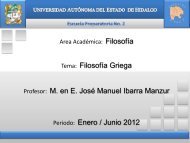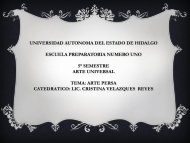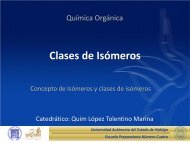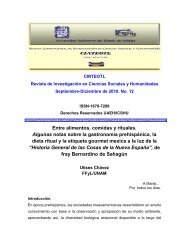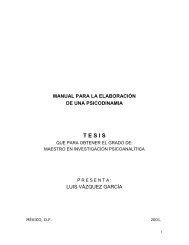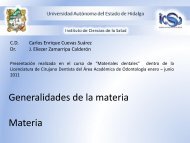Untitled-2 1 05/07/10 16:35 - Universidad Autónoma del Estado de ...
Untitled-2 1 05/07/10 16:35 - Universidad Autónoma del Estado de ...
Untitled-2 1 05/07/10 16:35 - Universidad Autónoma del Estado de ...
You also want an ePaper? Increase the reach of your titles
YUMPU automatically turns print PDFs into web optimized ePapers that Google loves.
Many fossils were collected during these excavation campaigns. The composition of<br />
the fossil assemblage at Vallecillo is known from a series of excavations carried out<br />
between 2003 and 2006. During excavation, 2<strong>10</strong>0 specimens have been registered and<br />
photo-documented, hence not all collected. Both types of collections differ consi<strong>de</strong>rably<br />
from the results, as shown by Ifrim et al. (this volume-b) and in Figures 5 and 19: the random<br />
collection, the material of which is mainly housed in the UANL-FCT, Linares, yields<br />
many well-preserved specimens and inclu<strong>de</strong>s rare taxa that yield an insight into the diversity<br />
of the Vallecillo biota. Collections based on the excavations, provi<strong>de</strong>d few well-preserved<br />
specimens, but first confi<strong>de</strong>nt data on the absolute composition of the Vallecillo<br />
assemblage (Ifrim, 2006; Ifrim et al., 20<strong>07</strong>, 2008b; this volume-a).<br />
The number of 5<strong>10</strong> <strong>de</strong>termined fish specimens reaches statistical significance and<br />
allows quantitative analysis of taxon abundances. In general the fish assemblage is characterized<br />
by a low taxonomic diversity. Recent studies on the fish fossils inclu<strong>de</strong> taphonomic<br />
interpretations. The abundance of fossils allows the taphonomic interpretation of the three<br />
most abundant Vallecillo fishes: Rhyncho<strong>de</strong>rcetis, Tselfatia, and Nursallia, all three of which<br />
differing in their locomotion type, feeding habits and preferred water <strong>de</strong>pths. They comprise<br />
85% of the excavated, <strong>de</strong>termined fish assemblage (Figure 19), but existed in the Turonian<br />
sea without interfering with each other (Ifrim et al., 20<strong>05</strong>a; Ifrim, 2006).<br />
References<br />
Blanco, A. & Alvarado-Ortega, J. 2006. Rhyncho<strong>de</strong>rcetis regio, sp. nov., a <strong>de</strong>rcetid fish<br />
(Teleostei: Aulopiformes) from Vallecillo, Nuevo León State, northeastern Mexico:<br />
Journal of Vertebrate Paleontology, 26 (3), 552-558.<br />
Blanco, A. & Cavin, L. 2003. New teleostei from the Agua Nueva Formation (Turonian), Vallecillo<br />
(NE Mexico): Comptes Rendus Paleovol, 2: 299-306.<br />
Blanco, A., Stinnesbeck, W., López-Oliva, J.-G., Frey, E., Adatte, T. & González, A. H. 2001.<br />
Vallecillo, Nuevo León: una nueva localidad fosilífera <strong><strong>de</strong>l</strong> Cretácico Tardío en el noreste<br />
<strong>de</strong> México: Revista Mexicana <strong>de</strong> Ciencias Geológicas, 18 (2): 196-199.<br />
Blanco-Piñon, A. 2003. Peces fósiles <strong>de</strong> la Formación Agua Nueva (Turoniano) en el Municipio<br />
<strong>de</strong> Vallecillo, Nuevo León, NE-México [PhD thesis]: <strong>Universidad</strong> <strong>Autónoma</strong> <strong>de</strong><br />
Nuevo León, 345 p.<br />
Blanco-Piñon, A. & Alvarado-Ortega, J. 20<strong>05</strong>. New <strong>de</strong>rcetid fish (Aulopiformes: Teleostei)<br />
from the early Turonian of Vallecillo, NE Mexico, 4th International Meeting on Mesozoic<br />
Fishes, Madrid, Abstract book: 43-46.<br />
Blanco-Piñon, A., Frey, E., Stinnesbeck, W. & López-Oliva, J. G. 2002. Late Cretaceous<br />
(Turonian) fish assemblage from Vallecillo, northeastern Mexico: Neues Jahrbuch für<br />
Geologie und Paläontologie, Abhandlungen, 225 (1): 39-54.<br />
Blanco-Piñon, A., Garibay-Romero, L. M. & Alvarado-Ortega, J. 20<strong>07</strong>. The ol<strong>de</strong>st stratigraphic<br />
record of the Late Cretaceous shark Ptychodus mortoni Agassiz, from Vallecillo,<br />
Nuevo León, northeastern Mexico: Revista Mexicana <strong>de</strong> Ciencias Geológicas, 24<br />
(1): 25-30.<br />
Blanco-Piñon, A., Shimada, K. & González-Barba, G. 20<strong>05</strong>. Lamnoid vertebrae from the<br />
132



